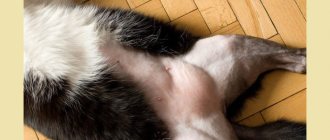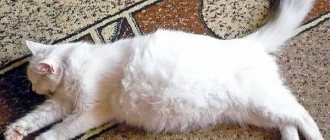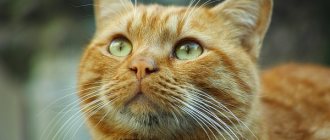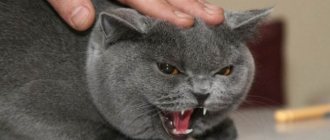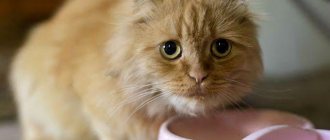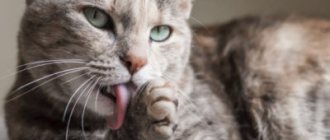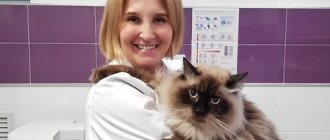Veronica Igorevna Sharipova
veterinarian Petstory
A cat's bloated abdomen is a common problem that cat owners usually bring to the veterinarian's office. There can be many reasons for this condition. And this pathology occurs in pets of all ages - from small kittens to older animals. How to understand what is happening to your pet, and what needs to be done if a cat has a swollen belly - we will talk about this in more detail in our article.
- If a prompt visit to the veterinarian is not possible
Possible causes of bloating
Next, we will consider the possible causes of a hard abdomen in a cat, conditionally dividing them into non-dangerous and dangerous (i.e., life-threatening for the pet).
Non-hazardous conditions
- Obesity is the scourge of modern domestic cats. Locked within four walls, cats do not hunt and move little, making obesity almost inevitable. Abundant deposits of subcutaneous fat in the abdominal area of a cat can form not only folds, but also a voluminous large belly.
- Pregnancy is a normal physiological process during which the pet's abdominal cavity increases significantly. Of course, this condition occurs only in females. Pregnancy often comes as a surprise to cat owners, especially if the pet ran outside the day before or you picked it up recently. Pregnancy in cats lasts about two months. If the cat has a large belly, but you are sure that she is not pregnant, it is still necessary to do an ultrasound of the abdominal cavity to exclude an “interesting” position.
- Flatulence, or bloating, can be classified as both non-dangerous and (in advanced cases) and dangerous conditions. Most often, this condition occurs when the pet is suddenly overfed (this often happens if we take a hungry cat from the street), when feeding spoiled food or giving food that is unsuitable for the cat (for example, a large portion of milk for a cat that is not used to drinking it).
Dangerous conditions
- Viral diseases that can lead to bloating. For example, infectious peritonitis is a dangerous, contagious and difficult to treat disease.
- Neoplasms , such as lymphoma, often produce effusion into the abdominal cavity and, as a result, a distended abdomen. Despite the fact that such conditions are most often incurable, timely diagnosis and chemotherapy can extend the pet’s life by several years.
- Heart disease can lead to something called congestive heart failure, which can cause fluid to accumulate in both the chest and abdomen.
- Coprostasis , or constipation, is a common problem in domestic cats. When the condition is neglected, the abdomen of cats and kittens enlarges, thickens, becomes inflated and hard. Unfortunately, enemas do not always help in such conditions, and surgery may be required.
- Kidney failure caused by diseases such as chronic kidney disease. In advanced cases, it can also lead to hydrops of the abdominal cavity, manifested by bloating in cats and kittens.
- Liver diseases , such as lipidosis and cirrhosis, cause blood to pool in the abdomen and result in ascites (dropsy), causing the cat's belly to become distended.
- Injuries , most often associated with a fall from a height, can lead to damage to the spleen, large vessels and other organs, causing internal bleeding and rapid enlargement of the abdomen.
- Pyometra , or purulent inflammation of the uterus, is very common in adult unsterilized cats, especially after the use of hormonal drugs to stop heat. It is for this reason that all cats are recommended to be sterilized.
- Worm infestation is much more common than domestic cat owners might imagine. In advanced cases, parasites can clog the intestinal wall, cause perforation of its wall, peritonitis and, as a result, the cat will have a painful, hard stomach.
Foods that cause flatulence in cats
Considering that in 90% of cases, flatulence is a consequence of poor nutrition, let’s consider foods that are at risk. If you have already encountered a problem, it is recommended to disassemble the diet “piece by piece” and, using the method of elimination, identify the product that is not digestible. Each organism is individual; if, after excluding obviously harmful products, the accumulation of gases bothers the cat, then we include everything in the “circle of suspects,” even meat.
In general, in order to reduce the risk of diseases of the digestive tract to a minimum, it is necessary to create a diet close to the “wild” way of life. Let's look at foods that are not typical for an adult cat:
Milk and dairy products - no matter how strange it may sound, some cats cannot digest the product due to lactose intolerance. In nature, a cat receives milk only from its mother, and when it grows up, it eats exclusively meat. However, if your pet tolerates milk or “live” yogurt well, go ahead, it is a source of many beneficial substances and friendly bacteria.
Fish - again, breaking stereotypes. Cats are not adapted to fishing in nature. If you manage to enjoy river fish at least occasionally, then there is no question of ocean fish. Tuna, sprat, herring, raw goby are delicacies that are allowed rarely and in very limited quantities. With daily feeding of fish, disturbances in the functioning of the central nervous system and kidney failure are possible due to an excess of phosphorus.
Cereals – feeding your pet soybean or wheat, corn, barley, semolina “porridge” is the first cause of flatulence. Gluten and large amounts of carbohydrates are an excellent source of food for bacteria. Of the grains, rice and buckwheat are recommended for cats. Bread is a cereal product and also contains yeast (big fans of releasing gases), so it is also not recommended for “muchriki”.
Garlic, onions, fatty, fried, spicy foods, expired foods and cheap industrial feeds irritate the intestinal walls. The inflamed intestinal mucosa is unable to support beneficial bacteria and “gas” bacteria take their place.
Associated symptoms
Associated symptoms of bloating include:
- depressed state of the pet;
- lethargy;
- rapid breathing;
- vomiting;
- lack of appetite;
- constipation;
- pale or icteric mucous membranes;
- increased thirst.
There may not be any other symptoms if, for example, the cat has a helminthic infestation or is simply obese.
How does it manifest?
If an animal is bothered by the accumulation of gases, it may meow pitifully.
Doctors note that the following symptoms are typical for flatulence:
- restless cat behavior;
- plaintive meow;
- vomit;
- constipation or diarrhea;
- rumbling in the stomach;
- muscle spasms;
- bloating;
- loss of appetite;
- thirst.
Diagnostics
Diagnosis of bloating must be comprehensive and include blood tests (general and biochemical), urine, abdominal ultrasound and x-rays. In some cases, especially if neoplasms are suspected, a CT scan is recommended.
The following are the primary diagnostic methods, depending on the suspicion of various causes of bloating:
- Obesity – weighing the pet, analyzing the diet, palpation;
- Pregnancy - ultrasound of the abdominal cavity;
- Flatulence - diet analysis, abdominal ultrasound;
- Viral disease - specific virological tests (PCR test of blood and effusion);
- Neoplasm – ultrasound of the abdominal cavity, plain X-ray in three projections, CT in the “oncology search” mode;
- Heart diseases – cardiac ECHO;
- Liver diseases - general and biochemical blood tests, ultrasound of the abdominal cavity;
- Kidney diseases - general and biochemical blood tests, abdominal ultrasound, urinalysis;
- Coprostasis – abdominal x-ray;
- Injuries – ultrasound of the abdominal cavity;
- Pyometra - ultrasound of the abdominal cavity;
- Helminthic infestation - stool analysis.
What to do:
- in all cases of abdominal enlargement, it is necessary to consult a doctor, regardless of the age of the animal - there are no options for “it will resolve on its own”!
– the faster the belly enlarges, the more urgent it should be to see a doctor. If there is a simultaneous significant deterioration in your health, you must go immediately to the clinic, where an ultrasound/X-ray and, if necessary, surgery can be performed.
– to independently monitor the amount of fluid in the abdominal cavity, you can use weighing + measuring the volume of the abdomen with a centimeter tape. Nevertheless, primary importance when choosing treatment tactics is given to the general condition of the animal and the degree of tension in the abdominal wall, and not to weight/volume.
Treatment
Treatment directly depends on the cause of bloating:
- Obesity requires a review of the pet's diet, a change in the frequency of feeding, as well as encouraging the cat to lead an active lifestyle;
- Pregnancy , of course, is not a disease and does not require treatment;
- If a cat has flatulence , then it is necessary to analyze its diet; it is possible to use a dietary diet; espumizan is used as symptomatic therapy;
- Viral diseases require specific treatment prescribed by a doctor;
- If a neoplasm is suspected, one type of biopsy is necessarily performed to identify the type of tumor, based on the results of which surgical or conservative treatment (chemotherapy) is prescribed;
- Heart diseases require special treatment depending on the type of disease and the stage of developed heart failure;
- Liver diseases are treated symptomatically and by following a strict diet;
- Kidney diseases , unfortunately, are mostly incurable (except for acute kidney injury); in this situation, only supportive treatment is used;
- For coprostasis , a cleansing enema or even surgical intervention is performed (in case of intestinal overdistension, lack of motility, and other pathologies), a diet analysis is also required, and sometimes oral laxatives are prescribed;
- Injuries most often require surgery;
- For pyometra in cats, only surgical treatment is used;
- Helminthic infestation is treated by using a course of anthelmintic drugs.
If a prompt visit to the veterinarian is not possible
If it is impossible to immediately take your pet to the veterinarian, and the cat’s stomach is swollen, then the algorithm of actions is as follows:
- Do not panic. Cats sense the owner’s stress very well and may also become nervous from increased attention, which can negatively affect their condition.
- Note the general well-being of your pet. Record and count the animal's respiratory rate per minute. Does your pet breathe from its belly? How does he sleep - as usual or only on his stomach? Is your appetite still there? What kind of chair does he have? Answering all these questions will help your veterinarian quickly make a diagnosis and prescribe treatment.
- Under no circumstances should you carry a cat in your arms; explain this to your children. Careless movements can aggravate the pet's condition, especially if the stomach is swollen as a result of injury or internal damage.
What can you do at home?
In continuation of the previous paragraph, you can add:
- If your cat's stomach and sides swell quickly, you can try applying a cold compress. Under no circumstances should you warm such a belly!
- The pet must be isolated from other cats, as this condition may be a sign of a dangerous viral infection.
Probability of death
The likelihood of death depends on the situation. The exact indicator is determined only by diagnostic results.
Remember that complications are possible even with non-hazardous factors. The bloating puts pressure on the chest, preventing normal breathing. There is also a high risk of gastric volvulus, intestinal rupture, tissue necrosis and sepsis. To avoid unpleasant consequences, contact your veterinarian if you have any alarming symptoms.
Prevention
Prevention of a bloated abdomen in a cat, as well as any other serious pet disease, comes down to following the rules for keeping cats in an apartment:
- It is necessary to regularly treat worms: kittens - once a month, adult cats - once every 3 months throughout their lives.
- Follow the principles of proper animal nutrition. If you are not sure about the chosen feeding tactics, make an appointment with a veterinary nutritionist: the doctor will be able to select not only ready-made food, but also a balanced homemade diet.
- It is advisable not to allow pets to walk outside to avoid infection with the feline infectious peritonitis virus, for which there is currently no vaccination.
- It is necessary to install special “anti-cat” nets on the windows, which prevent not only falling out of the window, but also getting stuck in windows open for ventilation.
Dosage forms and composition
Motilium contains the active dose of the substance domperidone. It is a strong dopamine receptor blocker. Several types of the drug are available for oral administration:
- Regular film-coated tablets: white, convex, engraved “10M”. Each contains 10 mg of domperidone, lactose, MCC, hydrogenated vegetable fat, starch, polyvidone and other auxiliary components. The package contains 1–3 blisters.
- Lingual lozenges with a similar dosage, slightly minty taste. The active substance in them is supplemented with gelatin, menthol, aspartame and mannitol. Packed in 10–30 pieces.
- Suspension for children. White, syrupy, sweetish liquid containing 1 mg of domperidone per 100 ml. Packaged in dark glass bottles with a screw cap. The drug also contains sodium saccharinate, water, sorbitol, polysorbate and stabilizers. Each package of the product has a special syringe for precise dosing.
